Mars
Mars is a rocky object further away from the Sun than Earth.
A more general definition of 'sky' allows for skies as seen on other worlds. At right is a 360° panorama of the horizon on Mars as perceived in the visual true-color range of the NASA Mars Exploration Rover 'Spirit' on November 23-8, 2005.
Planets
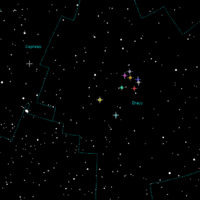
"In antiquity the classical planets were the non-fixed objects visible in the sky, known to various ancient cultures. The classical planets were therefore the Sun and Moon and the five non-earth [[planets] of our solar system closest to the sun (and closest to the Earth); all easily visible without a telescope. They are Mercury, Venus, Mars, Jupiter, and Saturn."[1]
"An orbital pole is either end of an imaginary line running through the center of an orbit perpendicular to the orbital plane, projected onto the celestial sphere. It is similar in concept to a celestial pole but based on the planet's orbit instead of the planet's rotation."[2]
"The north orbital pole of a celestial body is defined by the right-hand rule: If you curve the fingers of your right hand along the direction of orbital motion, with your thumb extended parallel to the orbital axis, the direction your thumb points is defined to be north."[2]
At right is a snapshot of the planetary orbital poles.[3] The field of view is about 30°. The yellow dot in the centre is the Sun's North pole. Off to the side, the orange dot is Jupiter's orbital pole. Clustered around it are the other planets: Mercury in pale blue (closer to the Sun than to Jupiter), "Venus in green, [the] Earth in blue, Mars in red, Saturn in violet, Uranus in grey [partly underneath Earth] and Neptune in lavender. Dwarf planet Pluto is the dotless cross off in Cepheus."[2]
Minerals
"Magnetite was detected in the first two rocks ground by Spirit."[4]
"Magnesian clay or clay-type minerals have been conclusively detected in the martian regolith."[5]
"Near-IR (0.65-2.55 µm) spectral observations of Mars using the Mauna Kea 2.2-m telescope in April 1980 show weak but definite absorption bands near 2.35 µm. ... The absorption band positions and widths match those produced by combined OH stretch and Mg-OH lattice modes and are diagnostic of minerals with structural OH such as clays and amphiboles. Likely candidate minerals include serpentine, talc, hectorite, and saponite."[5]
Meteors
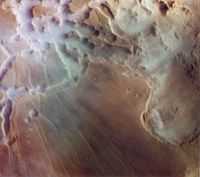
"Phoenix touched down on the Red Planet at 4:53 p.m. Pacific Time (7:53 p.m. Eastern Time), May 25, 2008, in an arctic region called Vastitas Borealis, at 68 degrees north latitude, 234 degrees east longitude."[6]
"As the sun rises over Noctis Labyrinthus (the labyrinth of the night), bright clouds of water ice can be observed in and around the tributary canyons of this high plateau region of Mars. This color composite image, reconstructed through violet, green, and orange filters, vividly shows the distribution of clouds against the rust colored background of this Martian desert."[7]
Cosmic rays
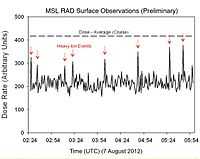
"NASA's Curiosity rover ... Radiation Assessment Detector instrument, or RAD, collected data for about 3 1/2 hours on Wednesday (Aug. 8)"[8]. As the Sun was relatively quiet in the direction of Mars, most of the spikes in the collected, unprocessed temporal spectrum are considered to be from galactic cosmic-radiation.[9]
"The data show that the radiation levels measured on Mars during this period of quiet solar activity are reduced from the average radiation detected in space during Curiosity's cruise to Mars. This is explained by the rover being on the planet versus out in space, where it would have more exposure to radiation from all directions. Red arrows point to spikes in the radiation dose rate from heavy ion particles, which would be the most dangerous to astronauts. ... RAD measures 26 kinds of charged particles as well as neutrons and gamma rays."[10]
Neutrals
"The major atmospheric gases on Earth, Venus, and Mars were probably CO2, H2O, and N2. [The ions from the upper parts of an atmosphere] are often suprathermal, and their interactions can produce suprathermal neutral atoms as well [The] ionopause [...] separates the bound ionosphere from an outer region in which the solar wind is diverted and flows around and past the planet. This region still contains some neutral gas, and if such atoms are ionized by solar photons or electron impact, they are swept up in the flow."[11]
"There are strong reasons to believe that Mars once had much more atmospheric CO2 and H2O than it now has ... (Impacts, which may have eroded even larger amounts, operated at an earlier period.) ... The visible polar caps are thought to contain relatively small quantities. [...] More recently it has been proposed (35) that Mars may have had several episodes of high atmospheric pressure, warm conditions, and substantial precipitation of rain and snow, with a north polar ocean and southern glaciers."[11]
Beta particles
"[L]uminescence dating techniques [may] provide absolute age determinations of eolian sediments on the surface of Mars, including those incorporated in the martian polar ice caps. Fundamental thermally and optically stimulated luminescence properties of bulk samples of JSC Mars-1 soil simulant [have been studied]. The radiation-induced luminescence signals (both thermoluminescence, TL, and optically stimulated luminescence, OSL) from JSC Mars-1 are found to have a wide dynamic dose–response range, with the luminescence increasing linearly to the highest doses used (936 Gy), following irradiation with 90Sr/90Y beta particles."[12]
Gamma rays
"The Gamma-Ray Spectrometer (GRS) on the 2001 Mars Odyssey spacecraft has mapped the surface abundances of [radiogenic heat-producing elements] HPEs across Mars."[13]
X-rays

"Apart from the Sun, the known X-ray emitters now include planets (Venus, Earth, Mars, Jupiter, and Saturn), planetary satellites (Moon, Io, Europa, and Ganymede), all active comets, the Io plasma torus, the rings of Saturn, the coronae (exospheres) of Earth and Mars, and the heliosphere."[14]
From the point of view of X-ray astronomy, Mars is a dwarf gaseous object.
At right is an X-ray image of Mars. X-radiation from the Sun excites oxygen atoms in the Martian upper atmosphere, about 120 km above its surface, to emit X-ray fluorescence. A faint X-ray halo that extends out to 7,000 km above the surface of Mars has also been found.[15] The Chandra X-ray Observatory image on the right is the first look at X-rays from Mars.
In X-ray astronomy, Mars is a gas dwarf.
Optical filters

"Most astronomical filters work by blocking a specific part of the color spectrum above and below a bandpass, significantly increasing the signal to noise of the interesting wavelengths, and so making the object more visible, 'contrasty', or defined. ... The broadband and narrowband filters transmit the wavelengths that are emitted by the nebulae (by the Hydrogen and Oxygen atoms), and are frequently used for reducing light pollution.[16]"[17]
"Color filters work by absorption/transmission, and can tell which part of the spectrum they are reflecting and transmitting. Filters can be used to increase contrast and enhance the details of the Moon and planets. All of the visible spectrum colors each have a filter, and every color filter is used to bring a certain lunar and planetary feature; for example, the #8 yellow filter is used to show Mars's maria and Jupiter's belts.[18] The Wratten system is the standard number system used to refer to the color filter types. ... Professional filters are also colored, but their bandpass centers are placed around other mid-points (such as in the UBVRI and Cousins systems)."[17]
The "Dark green: Improves cloud patterns on Venus. Reduces sky brightness during daylight observation of Venus. Increases contrast of ice and polar caps on Mars. Improves visibility of the Great Red Spot on Jupiter and other features in Jupiter atmosphere. Enhances white clouds and polar regions on Saturn."[17]
Visuals
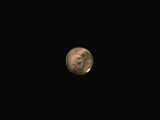
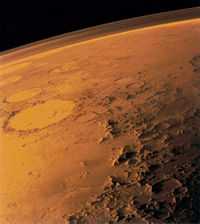
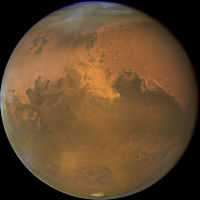
"Mars made its closest approach to Earth and maximum apparent brightness in nearly 60,000 years, 55,758,006 km (0.372719 AU), magnitude −2.88, on 27 August 2003 at 9:51:13 UT."[19]
"Mars is the fourth planet from the Sun in the Solar System. Named after the Roman god of war, Mars, it is often described as the "Red Planet" as the [iron(III) oxide] iron oxide prevalent on its surface gives it a reddish appearance.[20] ... The red-orange appearance of the Martian surface is caused by iron(III) oxide, more commonly known as hematite, or rust.[21] ... Much of the surface is deeply covered by finely grained iron(III) oxide dust.[22][23]"[19]
Blues
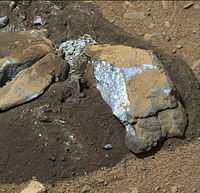
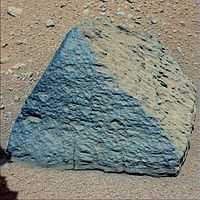

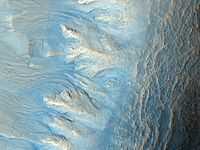
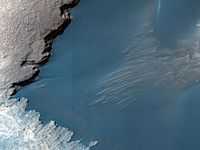
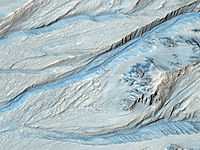

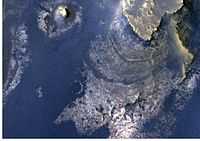

"The Mast Camera (Mastcam) on NASA's Mars rover Curiosity showed researchers interesting internal color in this rock called "Sutton_Inlier," which was broken by the rover driving over it. The Mastcam took this image during the 174th Martian day, or sol, of the rover's work on Mars (Jan. 31, 2013). The rock is about 5 inches (12 centimeters) wide at the end closest to the camera. This view is calibrated to estimated "natural" color, or approximately what the colors would look like if we were to view the scene ourselves on Mars. The inside of the rock, which is in the "Yellowknife Bay" area of Gale Crater, is much less red than typical Martian dust and rock surfaces, with a color verging on grayish to bluish."[24]
"[T]he Chemistry and Camera (ChemCam) instrument zapped [the rock known as "Jake Matijevic"] with its laser on Sept. 21, 2012, and Sept. 24, 2012, which were the 45th and 48th sol, or Martian day of operations. ... black and white images were taken by ChemCam to look for the pits produced by the laser. ... [Later] the Alpha Particle X-ray Spectrometer trained its view. ... This image was obtained by Curiosity's Mast Camera on Sept. 21, 2012 PDT (Sept. 22 UTC), or sol 46. [For natural color, processors] white-balanced the color in this view to increase the inherent differences visible within the rock."[25] Other bluish rocks can just be seen. Curiosity removed the Martian dust from "Jake Matijevic" before photographing.
At second left is an image in natural color by the HiRISE camera of Cerberus Fossae Graben showing exposed blue material.
The second image at right shows "the eastern (west-facing) side of an impact crater in the mid-latitudes of the Northern hemisphere."[26]
"Like many mid-latitude craters, this one has gullies along its walls that are composed of alcoves, channels, and debris aprons. The origins of these gullies have been the subject of much debate; they could have formed by flowing water, liquid carbon dioxide, or dry granular flows. The orientation of these gullies is of interest because many craters only contain gullies on certain walls, such as those that are pole-facing. This could be due to changes in orbital conditions and differences in solar heating along specific walls."[26]
"Many of the other features observed in and around this crater however are indicative of an ice-rich terrain, which may lend credence to the water formation hypothesis, at least for the gullies visible here. The most notable of these features is the "scalloped" terrain in and around the crater. This type of terrain has been interpreted as a sign of surface caving, perhaps due to sublimation of underlying ice. (Sublimation is the process of a solid changing directly to a gas.)"[26]
"Another sign of ice is the presence of parallel lineations and pitted material on the floor of the crater, similar to what is referred to as concentric crater fill. Parallel linear cracks are also observed along the crater wall over the gullies, which could be due to thermal contraction of ice-rich material."[26]
"All of these features taken together are evidence for ice-rich material having been deposited in this region during different climatic conditions that has subsequently begun to melt and/or sublimate under current conditions. More recently, aeolian deposits have accumulated around the crater as evidenced by the parallel ridges dominating the landscape. Dust devil streaks are also visible crossing the aeolian ridges."[26]
The image at third left "shows part of the floor of Rabe Crater, a large (108 kilometre diameter) impact crater in the Southern highlands".[27]
"Dark dunes—accumulations of wind blown sand—cover part of crater's floor, and contrast with the surrounding bright-colored outcrops. The extreme close-up view reveals a thumbprint-like texture of smaller ridges and troughs covering the surfaces of the larger dunes. These smaller ripples are also formed and shaped by blowing wind in the thin atmosphere of Mars."[27]
"One puzzling question is why the dunes are dark compared with the relative bright layered material contained within the crater. The probable answer is that the source of the dark sand is not local to this crater; rather, this topographic depression has acted as a sand trap that has collected material being transported by winds blowing across the plains outside the crater."[27]
The third image at right shows "pristine gullies, some with bright deposits, and perhaps very recent."[28]
"In addition, there is exposed bedrock, which at HiRISE resolution, we can pick out fine details. Observations like this can also help gully modeling."[28]
The fourth image at left shows an example of "[d]unes of sand-sized materials have been trapped on the floors of many Martian craters. This is one ... from a crater in Noachis Terra, west of the giant Hellas impact basin. The High Resolution Imaging Science Experiment (HiRISE) camera on NASA's Mars Reconnaissance Orbiter captured this view on Dec. 28, 2009."[29]
"The dunes here are linear, thought to be due to shifting wind directions. In places, each dune is remarkably similar to adjacent dunes, including a reddish (or dust colored) band on northeast-facing slopes. Large angular boulders litter the floor between dunes."[29]
The fourth image at right shows layered rocks on the floor of McLaughlin Crater.[30]
These "sedimentary rocks ... contain spectroscopic evidence for minerals formed through interaction with water. The High Resolution Imaging Science Experiment (HiRISE) camera on NASA's Mars Reconnaissance Orbiter recorded the image."[30]
"A combination of clues suggests this 1.4-mile-deep (2.2-kilometer-deep) crater once held a lake fed by groundwater. Part of the evidence is identification of clay and carbonate minerals within layers visible near the center of this image. The mineral identifications come from the Compact Reconnaissance Imaging Spectrometer for Mars (CRISM), also on the Mars Reconnaissance Orbiter. The scene covers an area about one-third of a mile (about 550 meters) across, at 337.6 degrees east longitude, 21.9 degrees north latitude. North is up."[30]
The fifth left image is a partial image of a recent impact crater on Mars captured by HiRISE. Although the HiRISE image does not show the entire crater, note that below the top rock layers cut through by the meteor is a blue layer. Some portions of this layer have slide down the crater wall beneath the layer. This suggests that the blue material is a layer beneath an outer Martian crust.
Cyans

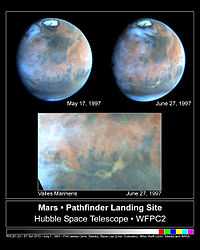
"The [true] color images of Mars [at right] were taken in 1999, across almost 60 million miles (!) by a talented amateur astronomer in Oeiras, Portugal - Antonio Cidadao."[31]
"They were acquired with a modest 10-inch "Schmidt-Cassegrain" reflecting telescope, and a commercially available CCD (charge coupled device) camera. Mr. Cidadao’s total investment in his "Mars imaging system" - commercial telescope and electronic camera, plus computer to process the images, and the appropriate software - was approximately three thousand American dollars."[31]
"In 1997, before the arrival of the Mars Pathfinder spacecraft (the first NASA Lander sent to Mars since Viking), the Hubble Telescope was tasked to acquire a series of "weather forecast Mars images" prior to the landing [at left]."[31]
"This long-distance reconnaissance detected a small dust storm less than a month before the Pathfinder arrival, which (with its potentially high winds) could have posed a serious threat to the Pathfinder entry and landing."[31]
"If dust diffuses to the landing site, the sky could turn out to be pink like that seen by Viking... otherwise [based on the Hubble images - above], Pathfinder will likely show blue sky with bright clouds."[32]
Greens
"[O]bservations from the SPICAM spectrometer on the Mars Express spacecraft ... of the [oxygen] green line [are compared with simulations]"[33].
"O(1S) [green line] emission is seen in the atmospheres of all three terrestrial planets -Venus, Earth, Mars."[34]
Oranges
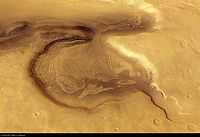
"Signs of glacial ice flows [occur] in the 582-mile-wide feature Deuteronilus Mensae [in the image at the left]."[35]
Reds

"La couleur rouge sang caractéristique de Mars lui valut dans l’Antiquité le rapprochement avec le dieu grec de la guerre Arès puis avec son équivalent romain Mars, le rouge évoquant le sang des champs de bataille. Les Babyloniens la nommaient Nirgal ou Nergal, le dieu de la mort, des destructions et du feu. Les Égyptiens la nommaient « Horus rouge » (ḥr Dšr, Hor-desher) et connaissaient son « déplacement à reculons » (actuellement connu sous le nom de mouvement rétrograde). Dans la mythologie hindoue, Mars est nommée Mangala (मंगल) du nom du dieu de la guerre. Mangala Vallis est nommé en son honneur."[36]
Tuesday is the day of the week for Mars and its color is red.[37]
Infrareds
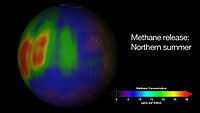
At right is an image generated by detecting methane in the Martian atmosphere by carefully observing the planet throughout several Mars years with NASA's Infrared Telescope Facility and the W.M. Keck telescope, both at Mauna Kea, Hawaii. The methane "plumes were seen over areas that show evidence of ancient ground ice or flowing water. Plumes appeared over the Martian northern hemisphere regions such as east of Arabia Terra, the Nili Fossae region, and the south-east quadrant of Syrtis Major, an ancient volcano about 745 miles across."[38]
Radars
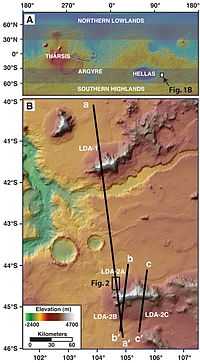
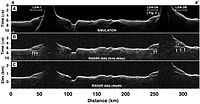

"Radar waves penetrate the surface and pass through materials that do not severely attenuate or scatter them. Reflections arise from interfaces with dielectric contrasts. [Shallow radar] SHARAD has penetrated the ∼2-km-thick polar layered deposits in both the north and south, detecting many internal reflectors (17, 18). Smaller targets can be more challenging because SHARAD's antenna pattern is broad, resulting in surface reflections up to a few tens of kilometers away from the suborbital point in rugged areas, versus only a few kilometers in smooth, flat areas. These off-nadir echoes can appear at time delays similar to those arising from subsurface interfaces, so steps are required to avoid misinterpreting this surface clutter as subsurface echoes. Synthetic-aperture data processing is used to improve along-track resolution to ∼300 m, greatly reducing along-track clutter and focusing the surface and subsurface features. We used the known topography of the surface and the radar geometry to model cross-track clutter together with nadir surface echoes [...]. Comparisons of radar sounding data with these synthetic surface echoes and the examination of possible surface echo sources in imagery (19) were undertaken for all cases [...]; such a procedure is a necessary part of radar sounding data interpretation in high-relief environments."[39]
The "Shallow Radar (SHARAD) (15) on the Mars Reconnaissance Orbiter (MRO) to probe the internal structure of several LDAs surrounding massifs on the eastern rim of the Hellas impact basin [first image at the right] where more than 90 LDA complexes flank steep topography (2, 6, 16). The southernmost LDA we studied (LDA-2, [figure at the upper right] has multiple lobes that coalesce to form a continuous deposit extending more than 20 km outward from a massif along ∼170 km of its margins."[39]
"Examination of radar data from SHARAD orbit 6830 where it crosses multiple [lobate debris aprons] LDAs in the eastern Hellas region [...] shows that the only radar reflections not matching simulated surface echoes occur where the spacecraft passes over each LDA [...]; therefore, these echoes are interpreted as arising from within or beneath the LDAs. In one case (LDA-2A), surface clutter is predicted near the terminus of the LDA, where it may obscure portions of a subsurface reflector that clearly extends farther inward below the LDA. LDA-2A and LDA-2B [image at the lower right] show evidence for multiple, closely spaced subsurface reflectors indicating the presence of at least one thin (∼70 m assuming a water-ice composition), distinct deposit below thicker deposits (up to 800 m)."[39]
Atmospheres

"A color image was made [at lower right] from the first post-sunset sequence of calibrated color images, with the color balance set to approximate what the sunset color would have looked like to the human eye. The color seen in this first post-sunset image was then used to colorize each image in the sequence. Approximately one-minute gaps between consecutive color images meant the Sun's position changed within each color set, so the images had to be manually shifted to compensate for this motion. In this fashion, the position and brightness of the Sun are taken from each individual image, but the color is taken from a single set of images. The images were then combined into a movie where one color set fades gracefully into the next. Analysis of the five color sets shows that there were only small color variations during the sunset, so most of the real variations are captured in the movie."[40]
"The rapid dimming of the Sun near the horizon is due to the dust in the sky. There is nearly twice as much dust as there was when the Mars Pathfinder spacecraft, which landed on Mars in 1997, imaged the sunset. This causes the Sun to be many times fainter. The sky above the Sun has the same blue tint observed by Pathfinder and also by Viking, which landed on Mars in 1976. This is because dust in the martian atmosphere scatters blue light forward toward the observer much more efficiently than it scatters red light forward. Therefore, a "halo" of blueish sky color is always observed close to the Sun. We're only seeing half of this halo in the movie, because the other half is below the horizon."[40]
Astroglaciology

"The discoveries of water ice on the Moon, Mars and Europa add an extraterrestrial component to the field, as in "astroglaciology".[41]"[42]
Extinct "Martian rivers indicate an ice-age climate for Mars coincident with the earth’s Pleistocene epoch, which further suggests the existence of extraterrestrial controls."[43]
"This is the south polar cap of Mars [on the right] as it appeared to the Mars Global Surveyor (MGS) Mars Orbiter Camera (MOC) on April 17, 2000. In winter and early spring, this entire scene would be covered by frost. In summer, the cap shrinks to its minimum size, as shown here. Even though it is summer, observations made by the Viking orbiters in the 1970s showed that the south polar cap remains cold enough that the polar frost (seen here as white) consists of carbon dioxide. Carbon dioxide freezes at temperatures around -125° C (-193° F). Mid-summer afternoon sunlight illuminates this scene from the upper left from about 11.2° above the horizon. Soon the cap will experience sunsets; by June 2000, this pole will be in autumn, and the area covered by frost will begin to grow. Winter will return to the south polar region in December 2000. The polar cap from left to right is about 420 km (260 mi) across."[44]
Astrognosy

"This artist's concept of the interior of Mars [on the right] shows a hot liquid core that is about one-half the radius of the planet. The core is mostly made of iron with some possible lighter elements such as sulfur. The mantle is the darker material between the core and the thin crust."[45]
"Mars has not cooled to a completely solid iron core, rather its interior is made up of either a completely liquid iron core or a liquid outer core with a solid inner core."[45]
"Earth has an outer liquid iron core and solid inner core. This may be the case for Mars as well."[45]
"Mars is influenced by the gravitational pull of the Sun. This causes a solid body tide with a bulge toward and away from the Sun (similar in concept to the tides on Earth). However, for Mars this bulge is much smaller, less than 1 centimeter (0.4 inch). By measuring this bulge in the Mars gravity field we can determine how flexible Mars is. The size of the measured tide is large enough to indicate the core of Mars can not be solid iron but must be at least partially liquid."[45]
"The tidal bulge is a very small but detectable force on the spacecraft. It causes a drift in the tilt of the spacecraft's orbit around Mars of one-thousandth of a degree over a month."[46]
"The precession is the slow motion of the spin pole of Mars as it moves along a cone in space (similar to a spinning top). For Mars, it takes 170,000 years to complete one revolution. The precession rate indicates how much the mass of Mars is concentrated toward the center. A faster precession rate indicates a larger dense core, compared to a slower precession rate."[45]
"Our results indicate the mass change for the southern carbon dioxide ice cap is 30 to 40 percent larger than the northern ice cap, which agrees well with the predictions of the global atmosphere models of Mars."[45]
"The amount of total mass change depends on assumptions about the shape of the sublimated portion of the cap. The largest mass exchange occurs if we assume the cap change is uniform or flat over the entire cap, while the lowest mass exchange corresponds to a conically shaped cap change."[45]
Plasma objects

"NASA’s Mars Atmosphere and Volatile Evolution (MAVEN) spacecraft has observed two unexpected phenomena in the Martian atmosphere: an unexplained high-altitude dust cloud and aurora that reaches deep into the Martian atmosphere."[47]
“If the dust originates from the atmosphere, this suggests we are missing some fundamental process in the Martian atmosphere.”[48]
"MAVEN’s Imaging Ultraviolet Spectrograph (IUVS) observed what scientists have named “Christmas lights.” For five days just before December 25th, MAVEN saw a bright ultraviolet auroral glow spanning Mars’ northern hemisphere. Aurora, known on Earth as northern or southern lights, are caused by energetic particles like electrons crashing down into the atmosphere and causing the gas to glow."[47]
“What’s especially surprising about the aurora we saw is how deep in the atmosphere it occurs — much deeper than at Earth or elsewhere on Mars. The electrons producing it must be really energetic.”[49]
"The source of the energetic particles appears to be the Sun. MAVEN’s Solar Energetic Particle instrument detected a huge surge in energetic electrons at the onset of the aurora. Billions of years ago, Mars lost a global protective magnetic field like Earth has, so solar particles can directly strike the atmosphere. The electrons producing the aurora have about 100 times more energy than you get from a spark of house current, so they can penetrate deeply in the atmosphere."[47]
"Both Earth and Mars have extensive coronae, whereas the Venus corona manifests itself almost entirely within two planetary radii. The Mars corona is relatively thin and exhibits a slight brightening at the dark limb."[50]
Magnetospheres
Mars has a magnetosphere.[51]
Gaseous objects
"Four hydrogen (H2) lines have been detected in a spectrum of Mars observed with the Far Ultraviolet Spectroscopic Explorer. ... The line intensities correspond to [an] H2 abundance ... above 140 kilometers on Mars. ... Analysis of [deuterium] fractionation among a few reservoirs of ice, water vapor, and molecular hydrogen on Mars implies that a global ocean more than 30 meters deep was lost since the end of hydrodynamic escape. Only 4% of the initially accreted water remained on the planet at the end of hydrodynamic escape, and initially Mars could have had even more water (as a proportion of mass) than Earth."[52]
Oxygens

An oxygen isotope "discrepancy was noted forty years ago in a stony meteorite that exploded over Pueblito de Allende, Mexico. It has since been confirmed in other meteorites, which are asteroids that fall to Earth. These meteorites are some of the oldest objects in the Solar System, believed to have formed nearly 4.6 billion years ago within the solar nebula’s first million years. The mix of oxygen-16 (the most abundant form with one neutron for each proton) and variants with an extra neutron or two is markedly different in the meteorites than that seen on terrestrial Earth, the moon or Mars."[53]
Craters

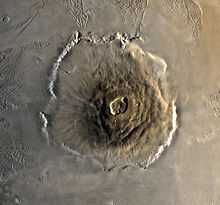
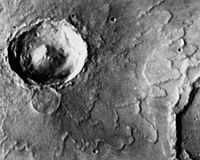
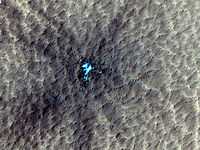



Catenae "on Mars, represent chains of collapse pits associated with grabens (see, for example, the Tithoniae Catenae near Tithonium Chasma)."[54] "Near the lower left corner of this view [at right] is the three-petal lander platform that NASA's Mars Exploration Rover Spirit drove off in January 2004. The lander is still bright, but with a reddish color, probably due to accumulation of Martian dust."[55]
"The High Resolution Imaging Science Experiment (HiRISE) camera on NASA's Mars Reconnaissance Orbiter recorded this view on Jan. 29, 2012, providing the first image from orbit to show Spirit's lander platform in color. The view covers an area about 2,000 feet (about 600 meters) wide, dominated by Bonneveille Crater. North is up. A bright spot on the northern edge of Bonneville Crater is a remnant of Spirit's heat shield."[55]
"The shield volcano, Olympus Mons [shown in the second image at right] (Mount Olympus), at 27 km is the second highest known mountain in the Solar System.[56] It is an extinct volcano in the vast upland region Tharsis, which contains several other large volcanoes. Olympus Mons is over three times the height of Mount Everest, which in comparison stands at just over 8.8 km.[57]"[19]
"Rampart craters are a specific type of Martian impact crater which are accompanied by distinctive fluidized ejecta features. A Martian Rampart crater displays an ejecta with a low ridge along its edge. Usually, rampart craters show a lobate outer margin, as if material moved along the surface, rather than flying up and down in a ballistic trajectory. The flows sometimes are diverted around small obstacles, instead of falling on them. The ejecta look as if they move as a mudflow. Some of the shapes of Rampart craters can be duplicated by shooting projectiles into mud. Although rampart craters can be found all over Mars, the smaller ones are only found in the high latitudes where ice is predicted to be close to the surface. It seems that the impact has to be powerful enough to penetrate to the level of the subsurface ice. Since ice is thought to be close to the surface in latitudes far from the equator, it does not take too strong of an impact to reach the ice level.[58] So, based on images from the Viking program in the 1970s, it is generally accepted that rampart craters are evidence of ice or liquid water beneath the surface of Mars. The impact melts or boils the water in the subsurface producing a distinctive pattern of material surrounding the crater."[59]
At the second left down is an image of a "newly formed impact crater, observed by HiRISE on Mars Reconnaissance Orbiter. The impact that formed the crater exposed the water ice beneath the surface. Some of the ice can be seen scattered at the adjascent area in the subimages. The blast zone (excavated dark material) is almost 800 meters (half a mile) across. The crater itself is just over 20 meters (66 feet) across".[60]
"This crater is one of a special group that have excavated down to buried ice. This ice gets thrown out of the crater onto the surrounding terrain. Although buried ice is common over about half the Martian surface, we can only easily discover craters in dusty regions. The overlap between areas that both have buried ice and surface dust is unfortunately small. So even though we have discovered over 100 new impact craters we have only discovered 7 new craters that expose buried ice."[60]
"When craters excavate this buried ice it tells us something about the extent and depth of buried ice on Mars (controlled by climate); this information is used by planetary scientists to figure out what the recent climate of Mars was like. It has also been a surprise that this ice is so clean. Scientists expected this buried ice to be a mixture of ice and dirt; instead this ice seems to have formed in pure lenses. Yet another surprise that Mars had in store for us!"[60]
The ice (presumably water ice) is white in the image, but take note of the blue dust or regolith also exposed.
The third image at right is a subimage of the one at left. It is natural color and shows in better detail both the ice (white) and the blue material.
At third left is an image showing an impact crater on Planum Boreum, or the North Polar Cap, of Mars, as observed by HiRISE on Mars Reconnaissance Orbiter in natural color.
"Impact craters on the surface of Planum Boreum, popularly known as the north polar cap, are rare. This dearth of craters has lead scientists to suggest that these deposits may be geologically young (a few million years old), not having had much time to accumulate impact craters throughout their lifetime."[61]
"It is also possible that impacts into ice do not retain their shape indefinitely, but instead that the ice relaxes (similar to glass in an old window), and the crater begins to disappear. This subimage shows an example of a rare, small crater ( approximately 115 meters, or 125 yards, in diameter). Scientists can count these shallow craters to attain an estimate of the age of the upper few meters of the Planum Boreum surface."[61]
"The color in the enhanced-color example comes from the presence of dust and of ice of differing grain sizes. The blueish ice has a larger grain size than the ice that has collected in the crater. The reddish material is dust. The smooth area stretching to the upper right, away from the crater may be due to winds being channeled around the crater or to fine-grained ice and frost blowing out of the crater."[61]
The fourth image at right shows a freshly formed impact crater that occurred on Mars between February 2005 and July 2005.[62] Note the blue material expelled from the crater rock onto the nearby Martian landscape.
Planetary astronomy
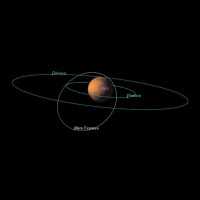
.jpg)
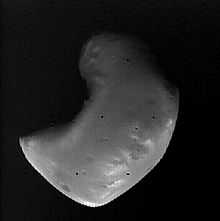
The Mars system consists of the rocky objects Mars, Phobos and Deimos.
Earth
"Mars made its closest approach to Earth and maximum apparent brightness in nearly 60,000 years, 55,758,006 km (0.372719 AU; 34,646,400 mi), magnitude −2.88, on 27 August 2003 at 9:51:13 UT."[19]
Meteorites
.jpg)
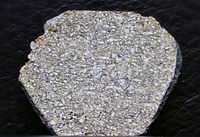
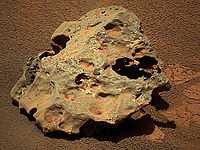
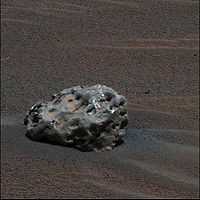
"Meteorites have been found on [...] Mars.[63]"[64]
"This [image at right] is a false-color, red-green-blue composite view generated from images taken through the Pancam's 750-nanometer, 530-nanometer and 430-nanometer filters. The exaggeraged color is used for enhancing the visibility of differences among the types of rock and soil materials."[65]
"Analysis of Block Island's composition using the rover's alpha particle X-ray spectrometer confirmed that it is rich in iron and nickel. The rock is about 60 centimeters (2 feet) across."[65]
Imaged at lower right is an igneous Martian shergottite meteorite. "The perimeter exhibits a fusion crust from the heat of entry into the Earth’s atmosphere. It is a fresh sample of NWA 6963, an igneous Martian shergottite meteorite found in September 2011 in Morocco. Meteorites are often labeled NWA for North West Africa, not because they land there more often, but because they are easy to spot as peculiar objects in the desert sands. From the geochemistry and presence of various isotopes, the origin and transit time is deduced. The 99 meteorites from Mars exhibit precise elemental and isotopic compositions similar to rocks and atmosphere gases analyzed by spacecraft on Mars, starting with the Viking lander in 1976. Compared to other meteorites, the Martians have younger formation ages, unique oxygen isotopic composition (consistent for Mars and not for Earth), and the presence of aqueous weathering products. A trapped gas analysis concluded that their origin was Mars quite recently, in the year 2000."[66]
"The formation ages of meteorites often come from their cosmic-ray exposure (CRE), measured from the nuclear products of interactions of the meteorite in space with energetic cosmic ray particles. This one is particularly young, having crystallized only 180 million years ago, suggesting that volcanic activity was still present on Mars at that time. Volcanic flows are the youngest part of a planet, and this one happened to be hit by a meteor impact, ejecting" it from the youthful Mars.[66]
"The Martian (SNC) meteorites are critically important for understanding Mars because they provide details of petrography and chemistry that cannot (yet) be measured in situ, and they provide ‘‘ground truths’’ for spectral analyses from the Martian surface using Mo¨ssbauer, thermal emission, and visible, near-IR, and mid-IR reflectance techniques. The recent discovery of a new 815 g Martian meteorite in the Miller Range of Antarctica [Satterwhite and Righter, 2004] provides us with a new sample with which to test hypotheses developed in studies of other nakhlite samples."[67]
The image third down on the right is of the Mackinac Island meteorite, discovered on Mars by the NASA Opportunity rover on October 13, 2009.[68]
At top left is "the first meteorite of any type ever identified on another planet. The pitted, basketball-size object is mostly made of iron and nickel. Readings from spectrometers on the rover determined that composition. Opportunity used its panoramic camera to take the images used in this approximately true-color composite on the rover's 339th martian day, or sol (Jan. 6, 2005). This composite combines images taken through the panoramic camera's 600-nanometer (red), 530-nanometer (green), and 480-nanometer (blue) filters."[69]
Comparison of the two meteorites shown here suggests that the left one is a much more recent fall.
Asteroids
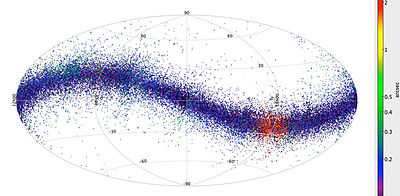
Large numbers of asteroids as indicated in the image from Gaia at the top ranging in size from Ceres to dust particles are found in the asteroid belt especially between the orbits of Mars and Jupiter.
Def. a "naturally occurring solid object, which is smaller than a planet and is not a comet, that orbits a star"[70] is called an asteroid.
Usage notes
"The term "asteroid" has never been precisely defined. It was coined for objects which looked like stars in a telescope but moved like planets. These were known from the asteroid belt between Mars and Jupiter, and were later found co-orbiting with Jupiter (Trojan asteroids) and within the orbit of Mars. They were naturally distinguished from comets, which did not look at all starlike. Starting in the 1970s, small non-cometary bodies were found outside the orbit of Jupiter, and usage became divided as to whether to call these "asteroids" as well. Some astronomers restrict the term "asteroid" to rocky or rocky-icy bodies with orbits up to Jupiter. They may retain the term planetoid for all small bodies, and thus tend to use it for icy or rocky-icy bodies beyond Jupiter, or may use dedicated words such as centaurs, Kuiper belt objects, transneptunian objects, etc. for the latter. Other astronomers use "asteroid" for all non-cometary bodies smaller than a planet, even large ones such as Sedna and (occasionally) Pluto. However, the distinction between asteroid and comet is an artificial one; many outer "asteroids" would become comets if they ventured nearer the Sun. The official terminology since 2006 has been small Solar System body for any body that orbits the Sun directly and whose shape is not dominated by gravity."[70]
Earth crossers
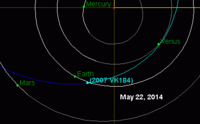
EC denotes Earth-crossing.[71]
"50 % of the MB Mars-crossers [MCs] become ECs within 59.9 Myr and [this] contribution ... dominates the production of ECs".[71]
Apollo asteroids
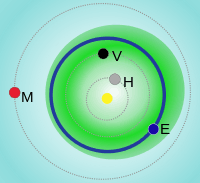
|
Mars (M) Venus (V) Mercury (H) |
Sun Apollo asteroids Earth (E) |
Note that sizes and distances of bodies and orbits are not to scale in the image on the right.
As of 2015, the Apollo asteroid group includes a total of 6,923 known objects of which 991 are numbered (JPL SBDB).
Mars crossers
"50 % of the MB Mars-crossers [MCs] become ECs within 59.9 Myr".[71]
Amor asteroids
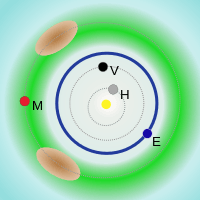
Note that sizes and distances of bodies and orbits are not to scale. Credit: AndrewBuck.
Mars Trojans
From the diagram in the section Amor asteroids, the Mars Trojans occupy comparable positions relative to Mars that the Trojan asteroids do to Jupiter.
Asteroid belts
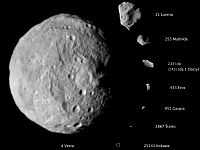
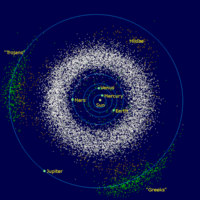
Def. a "region of the orbital plane of the solar system located between the orbits of Mars and Jupiter which is occupied by numerous minor planets and the dwarf planet Ceres"[72] is called an asteroid belt.
"The MB group is the most numerous group of MCs. ... 50 % of the MB Mars-crossers [MCs] become ECs within 59.9 Myr and [this] contribution ... dominates the production of ECs"[71]. MB denotes the main belt of asteroids.[71]
"The interplanetary medium includes interplanetary dust, cosmic rays and hot plasma from the solar wind. The temperature of the interplanetary medium varies. For dust particles within the asteroid belt, typical temperatures range from 200 K (−73 °C) at 2.2 AU down to 165 K (−108 °C) at 3.2 AU[73] The density of the interplanetary medium is very low, about 5 particles per cubic centimeter in the vicinity of the Earth; it decreases with increasing distance from the sun, in inverse proportion to the square of the distance. It is variable, and may be affected by magnetic fields and events such as coronal mass ejections. It may rise to as high as 100 particles/cm³."[74]
"The hydromagnetic approach led to the discovery of two important observational regularities in the solar system: (1) the band structure [such as in the rings of Saturn and in the asteroid belt], and (2) the cosmogonic shadow effect (the two-thirds fall down effect)."[75]
"The majority of known asteroids orbit within the asteroid belt between the orbits of Mars and Jupiter ... This belt is now estimated to contain between 1.1 and 1.9 million asteroids larger than 1 km in diameter,[76] and millions of smaller ones.[77]"[78]
Nysian asteroids
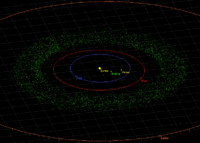
The Nysian asteroids occur primarily between the orbits of Mars and Jupiter but some are between Earth and Mars.
Comets
"A comet that flew close to Mars showered the red planet with fine cometary dust, according to observations by a trio of spacecraft."[79]
"Comet C/2013 A1 Siding Spring passed within 139,500 kilometres of the red planet on 19 October, the closest a comet has ever been seen to come to a planet without actually colliding with it. To avoid being damaged by the comet dust, all spacecraft orbiting Mars moved to the far side of the planet for 20 minutes while the comet dust was at its most intense, but this did not prevent them from studying the effects it had on Mars’ atmosphere."[79]
“They call this comet encounter a once-in-a-lifetime event, but it’s more like once in a million years.”[80]
"The European Space Agency’s Mars Express spacecraft detected an increase in electrons in Mars’ upper atmosphere, partly ionising it. This was attributed to fine cometary dust penetrating the atmosphere, which led to a meteor storm of thousands of meteors per hour. The increase in electrons led to the creation of a temporary new layer of charged particles in the ionosphere, which runs from an altitude of 120 kilometres to several hundred kilometres above. This is the first time such an event has been seen, even on Earth the extra density of electrons was measured to be five to ten times higher than normal by NASA’s Mars Reconnaissance Orbiter. Another NASA spacecraft, MAVEN, which also observed the new layer in the ionosphere, will monitor for any long-term events as it goes about its regular duties of studying Mars’ atmosphere."[79]
"MAVEN’s Imaging Ultraviolet Spectrograph was able to ascertain the species of ions that flooded into the ionosphere from the comet, the first time a comet that has come direct from the distant Oort Cloud has been sampled in this way. It detected the signal of magnesium, iron and sodium ions following the meteor shower, a signal that dominated Mars’ ultraviolet spectrum for hours afterwards, taking two days to dissipate."[79]
"The results show that dust from the comet, which has a nucleus two kilometres across, according to high resolution images from the Mars Reconnaissance Orbiter, had a dramatic effect on Mars’ atmosphere."[79]
“Observing the effects on Mars of the comet’s dust slamming into the upper atmosphere makes me very happy that we decided to put our spacecraft on the other side of Mars at the peak of the dust tail passage and out of harm’s way.”[81]
Atlantic history
The "Atlantic period [is] 4.6–6 ka [4,600-6,000 b2k]."[82]
Early history
The early history period dates from around 3,000 to 2,000 b2k.
Subboreal history
The "period around 850-760 BC [2850-2760 b2k], characterised by a decrease in solar activity and a sharp increase of Δ 14C [...] the local vegetation succession, in relation to the changes in atmospheric radiocarbon content, shows additional evidence for solar forcing of climate change at the Subboreal - Subatlantic transition."[83]
The "Holocene climatic optimum in this interior part of Asia [Lake Baikal] corresponds to the Subboreal period 2.5–4.5 ka".[82]
"Violent earthshocks and other perturbations of nature destroyed the Mycenaean citadels and left their defenders exposed to the assaults of migrant tribes, dislodged in the same upheavals, and calling themselves the Children of Heracles, or Mars."[84]
"At the end of the eighth century and the beginning of the seventh century before the present era, when every fifteen years Mars was approaching dangerously close to the Earth, Isaiah prophesied “the day of the Lord’s vengeance,” in which day “the streams [of Idumea] shall be turned into pitch, and the dust thereof into brimstone, and the land thereof shall become burning pitch.” (8) [Isaiah 34:9] A curse upon man and his land was that “brimstone shall be scattered upon his habitation.” (9) [Job 18:15] “Upon the wicked he shall rain pitch, fire and brimstone, and a horrible tempest.” (10) [Psalm 11:6] This eschatological vision was alive with Ezekiel in the days of the Babylonian Exile. He spoke about “an overflowing rain, and great hailstones [meteorites], fire and brimstone.” (11) [Ezekiel 38:22]"[85]
Subatlantic history
The "calibration of radiocarbon dates at approximately 2500-2450 BP [2500-2450 b2k] is problematic due to a "plateau" (known as the "Hallstatt-plateau") in the calibration curve [...] A decrease in solar activity caused an increase in production of 14C, and thus a sharp rise in Δ 14C, beginning at approximately 850 cal (calendar years) BC [...] Between approximately 760 and 420 cal BC (corresponding to 2500-2425 BP [2500-2425 b2k]), the concentration of 14C returned to "normal" values."[83]
Astrohistory
Babylonian astronomy
"Babylonian astronomy, too, had a four-planet system. In ancient prayers the planets Saturn, Jupiter, Mars, and Mercury are invoked; ... and one speaks of "the four-planet system of the ancient astronomers of Babylonia."[86]
ca. 2626 b2k “By the period of the Neo-Babylonian Empire, the Babylonian astronomers were making regular records of the positions of the planets and systematic observations of their behavior. For Mars, they knew that the planet made 37 synodic periods, or 42 circuits of the zodiac, every 79 years. They also invented arithmetic methods for making minor corrections to the predicted positions of the planets.[87][88]”.[19]
Celtic astronomy
"Mercury was the most honoured of all the gods and many images of him were to be found. Mercury was regarded as the inventor of all the arts, the patron of travellers and of merchants, and the most powerful god in matters of commerce and gain. After him, the Gauls honoured Apollo, who drove away diseases, Mars, who controlled war, Jupiter, who ruled the heavens, and Minerva, who promoted handicrafts. He adds that the Gauls regarded Dis Pater as their ancestor.[89] ... [The names of Roman gods] are coupled with native Celtic theonyms and epithets, such as Mercury Visucius, Lenus Mars, Jupiter Poeninus, or Sulis Minerva."[90]
Chinese astronomy
3045 b2k "Chinese records about the appearances and motions of Mars appear from before the founding of the Zhou Dynasty (1045 BCE),"[91].
~2400 b2k: “Literature from ancient China confirms that Mars was known by Chinese astronomers by no later than the fourth century BCE.[92]”[19].
2221 b2k "Chin Dynasty (221 BCE) astronomers maintained close records of planetary conjunctions, including those of Mars."[91]
Egyptian astronomy
~3534 b2k “The existence of Mars as a wandering object in the night sky was recorded by the ancient Egyptian astronomers and by 1534 BCE they were familiar with the retrograde motion of the planet.[93]”.[19]
~3458 b2k "Mars was portrayed on the ceiling of the tomb of Seti I and on the Ramesseum ceiling, though it was missing from the Senenmut star map [ Hatshepsut reigned (1479 BC – 1458 BC)]. In the latter case, the planet may have been in conjunction with the Sun.[94]"[91]
Greek astronomy
~2300 b2k: “In the fourth century BCE, Aristotle noted that Mars disappeared behind the Moon during an occultation, indicating the planet was farther away.[95]”.[19]
“Uranus was the Sky in Greek mythology, which was thought to be dominated by the combined powers of the Sun and Mars.[96]”[97]
Hindu astronomy
5102 b2k, is the historical year assigned to a Hindu table of planets that does include the Sun, Mercury (or Hermes), "Hermès observait en -1660; donc les Indiens observaient en -3102, et ils observaient bien!", the Moon, Mars is mentioned, Jupiter, Saturn, but does not include Venus.[98]
The planetary equivalents of the Hindu are "Sourya est le Soleil; Bouddha, Mercury; Soucra, Vénus; Mangala, Mars; Vrihaspati, Jupiter; Sani, Saturne; [et] Tchandra, la Lune"[98].
Astrophysics
By observing many of the wandering lights in the night sky, an occasional occultation of the light of one astronomical object may occur by the intervention of another along a closer astronomical stratum. On April 25, 1838, an occultation of Mercury by the Moon occurred when Mercury was visible to the unaided eye after sunset.[99] An occultation of Venus by the Moon occurred "on the afternoon of October 14", 1874.[99] An earlier such occultation "occurred on May 23, 1587, and is thus recorded by [Tycho Brahe] in his Historia Celestis"[99]. "Thomas Street, in his Astronomia Carolina (A.D. 1661), mentions three occultations by Venus, being two occasions when the planet covered Regulus, and once when there was an occultation of Mars by Venus."[99] "[Thomas Street] describes [the occultation of Mars by Venus] as follows: "1590,. Oct. 2nd, 16h. 24s. Michael Mœstlin observed ♂ eclipsed by ♀.""[99]
Technology
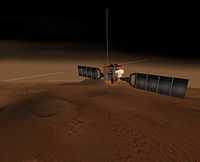
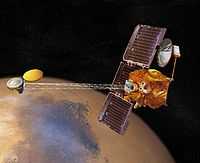
"In 1997, before the arrival of the Mars Pathfinder spacecraft (the first NASA Lander sent to Mars since Viking), the Hubble Telescope was tasked to acquire a series of "weather forecast Mars images" prior to the landing [at left]."[31]
"[O]bservations from the SPICAM spectrometer on the Mars Express spacecraft ... of the [oxygen] green line [are compared with simulations]".[33]
See also
References
- ↑ "Classical planets, In: Wikipedia". San Francisco, California: Wikimedia Foundation, Inc. 15 February 2014. Retrieved 2014-02-15.
- 1 2 3 "Orbital pole, In: Wikipedia". San Francisco, California: Wikimedia Foundation, Inc. December 17, 2012. Retrieved 2013-01-20.
- ↑ J. Herschel (June 1918). "The poles of planetary orbits". The Observatory 41: 255-7. http://adsabs.harvard.edu/full/1918Obs....41..255H. Retrieved 2013-07-10.
- ↑ P. Bertelsen, W. Goetz, M. B. Madsen, K. M. Kinch, S. F. Hviid, J. M. Knudsen, H. P. Gunnlaugsson, J. Merrison, P. Nørnberg, S. W. Squyres, J. F. Bell III, K. E. Herkenhoff, S. Gorevan, A. S. Yen, T. Myrick, G. Klingelhöfer, R. Rieder, R. Gellert (August 2004). "Magnetic properties experiments on the Mars Exploration Rover Spirit at Gusev crater". Science 305 (5685): 827-9. doi:10.1126/science.1100112. http://www.sciencemag.org/content/305/5685/827.short. Retrieved 2014-01-10.
- 1 2 Robert B. Singer, Pamela D. Owensby, and Roger N. Clark (June 1984). "First Direct Detection of Clay Minerals on Mars". Bulletin of the American Astronomical Society 16 (06): 679. http://adsabs.harvard.edu/full/1984BAAS...16R.679S. Retrieved 2014-01-10.
- ↑ Susan Watanabe (May 29, 2008). "Polygonal Pattern on Mars". Washington, DC USA: NASA. Retrieved 2013-03-31.
- ↑ Sue Lavoie (February 21, 2001). "PIA03213: Noctis Labyrinthus". Pasadena, California USA: NASA/JPL. Retrieved 2013-04-01.
- ↑ Mike Wall (August 9, 2012). "Mars Rover Curiosity Measures Red Planet Radiation". news.yahoo.com. Retrieved 2012-08-17.
- ↑ Don Hassler (August 8, 2012). "Curiosity Takes First Cosmic Ray Sample on Surface". www.space.com/NASA. Retrieved 2012-08-17.
- ↑ NASA/JPL-Caltech/SWRI (August 8, 2012). "Curiosity's First Radiation Measurements on Mars". Pasadena, California: NASA/JPL. Retrieved 2012-08-19.
- 1 2 Donald M. Hunten (February 12, 1993). "Atmospheric Evolution of the Terrestrial Planets". Science 259 (5097): 915-20. http://www.csun.edu/~hmc60533/CSUN_311/article_references/Sc_Feb93_AtmosEvolTerrestPlanets.pdf. Retrieved 2014-09-21.
- ↑ Kenneth Lepper and Stephen W.S. McKeever (April 2000). "Characterization of Fundamental Luminescence Properties of the Mars Soil Simulant JSC Mars-1 and Their Relevance to Absolute Dating of Martian Eolian Sediments". Icarus 144 (2): 295–301. doi:10.1006/icar.1999.6295. http://www.sciencedirect.com/science/article/pii/S0019103599962954. Retrieved 2014-09-21.
- ↑ B. C. Hahn, S. M. McLennan, E. C. Klein (July 2011). "Martian surface heat production and crustal heat flow from Mars Odyssey Gamma-Ray spectrometry". Geophysical Research Letters 38 (14). doi:10.1029/2011GL047435. http://onlinelibrary.wiley.com/doi/10.1029/2011GL047435/full. Retrieved 2013-05-09.
- ↑ Anil Bhardwaj, Ronald F. Elsner, G. Randall Gladstone, Thomas E. Cravens, Carey M. Lisse, Konrad Dennerl, Graziella Branduardi-Raymont, Bradford J. Wargelin, J. Hunter Waite Jr., Ina Robertson, Nikolai Østgaard, Peter Beiersdorfer, Steven L. Snowden, Vasili Kharchenko (June 2007). "X-rays from solar system objects". Planetary and Space Science 55 (9): 1135-89. doi:10.1016/j.pss.2006.11.009. http://web.ift.uib.no/~nikost/papers/Solar_System_X-rays_PSS_review_revised_paper.pdf. Retrieved 2013-05-23.
- ↑ K. Dennerl (November 2002). "Discovery of X-rays from Mars with Chandra". Astronomy & Astrophysics 394 (11): 1119-28. doi:10.1051/0004-6361:20021116.
- ↑ "astronomy for everyone: the use of filters". Retrieved 2010-11-22.
- 1 2 3 "Astronomical filter, In: Wikipedia". San Francisco, California: Wikimedia Foundation, Inc. 25 January 2013. Retrieved 2013-01-25.
- ↑ "filters - popular and hot telescope filters". Lumicon international. Retrieved 2010-11-22.
- 1 2 3 4 5 6 7 8 "Mars, In: Wikipedia". San Francisco, California: Wikimedia Foundation, Inc. March 31, 2013. Retrieved 2013-03-31.
- ↑ "The Lure of Hematite". Science@NASA. NASA. March 28, 2001. Retrieved 2009-12-24.
- ↑ Mark Peplow. "How Mars got its rust". BioEd Online. MacMillan Publishers Ltd. Retrieved 2007-03-10.
- ↑ Philip R. Christensen, et al. (June 27, 2003). "Morphology and Composition of the Surface of Mars: Mars Odyssey THEMIS Results". Science 300 (5628): 2056–61. doi:10.1126/science.1080885. PMID 12791998.
- ↑ Matthew P. Golombek (June 27, 2003). "The Surface of Mars: Not Just Dust and Rocks". Science 300 (5628): 2043–2044. doi:10.1126/science.1082927. PMID 12829771.
- ↑ Tony Greicius (March 18, 2013). "Bluish Color in Broken Rock in 'Yellowknife Bay'". NASA. Retrieved 2013-03-31.
- ↑ Phil Davis and James Green (October 11, 2012). "Target: Jake Matijevic Rock". Pasadena, California USA: NASA/JPL. Retrieved 2013-03-31.
- 1 2 3 4 5 Dan Berman (June 2, 2010). "Northern Hemisphere Gullies on West-Facing Crater Slope". Tucson, Arizona USA: University of Arizona. Retrieved 2013-05-25.
- 1 2 3 Brad Thomson (December 15, 2010). "Thumbprint Texture on Dark Dunes in Rabe Crater". Tucson, Arizona USA: University of Arizona. Retrieved 2013-05-25.
- 1 2 HiRISE Science Team (May 25, 2011). "Well-Preserved Gullied Impact Crater". Tucson, Arizona USA: University of Arizona. Retrieved 2013-05-25.
- 1 2 Yvette Smith (January 21, 2010). "Dunes of Mars". Tucson, Arizona USA: NASA/JPL-Caltech/University of Arizona. Retrieved 2013-05-25.
- 1 2 3 Sue Lavoie (January 20, 2013). "PIA16710: Layers with Carbonate Content Inside McLaughlin Crater on Mars". Tucson, Arizona USA: NASA/JPL-Caltech/University of Arizona. Retrieved 2013-05-25.
- 1 2 3 4 5 Richard C. Hoagland (2002). "Revealing Mars' True Colors ... of NASA". TheEnterpriseMission Website. Retrieved 2014-02-25.
- ↑ Philip James (2002). "Revealing Mars' True Colors ... of NASA". TheEnterpriseMission Website. Retrieved 2014-02-25.
- 1 2 Guillaume Gronoff, Cyril Simon Wedlund, Christopher J. Mertens, Mathieu Barthélemy, Robert J. Lillis, Olivier Witasse (May 2012). "Computing uncertainties in ionosphere-airglow models: II. The Martian airglow". Journal of Geophysical Research 117 (A5). doi:10.1029/2011JA017308.
- ↑ Tom Slanger, Brian Sharpee, Dusan Pejakovic, Richard Gattinger, Edward J. Llewellyn, Ian McDade, David Siskind, Kenneth Minschwaner (July 18, 2010). "The 557.7 and 297.2 nm lines of O(1S) in the atmospheres of the terrestrial planets". 38th COSPAR Scientific Assembly: 9.
- ↑ G. Neukum (25 January 2013). "Grab a paddle, we’re headed down Mars’ Reull Vallis". Berlin: ESA/DLR/FU Berlin. Retrieved 2014-09-26.
- ↑ "Mars (planète), In: Wikipedia". San Francisco, California: Wikimedia Foundation, Inc. May 6, 2012. Retrieved 2012-05-11.
- ↑ Lloyd D. Graham (Summer 2010). "The Seven Seals of Revelation and the Seven Classical Planets". The Esoteric Quarterly 6: 45-58. http://scholar.googleusercontent.com/scholar?q=cache:i0aRQgg7xGAJ:scholar.google.com/+%22classical+planets%22&hl=en&as_sdt=0,3. Retrieved 2012-05-21.
- ↑ Phil Davis (June 24, 2011). "Methane on Mars". National Aeronautics and Space Administration. Retrieved 2012-07-20.
- 1 2 3 John W. Holt, Ali Safaeinili, Jeffrey J. Plaut, James W. Head, Roger J. Phillips, Roberto Seu, Scott D. Kempf, Prateek Choudhary, Duncan A. Young, Nathaniel E. Putzig, Daniela Biccari, Yonggyu Gim (November 2008). "Radar Sounding Evidence for Buried Glaciers in the Southern Mid-Latitudes of Mars". Science 322 (5905): 1235-8. doi:10.1126/science.1164246. http://www.sciencemag.org/content/322/5905/1235.full. Retrieved 2014-09-28.
- 1 2 Sue Lavoie (February 26, 2004). "PIA05343: The Sun Sets on Mars". Pasadena, California USA: NASA/JPL. Retrieved 2013-04-01.
- ↑ Richard S. Williams, Jr. (1987). Annals of Glaciology. 9. International Glaciological Society. p. 255. http://www.igsoc.org/annals/9/igs_annals_vol09_year1987_pg254-255.pdf. Retrieved 7 February 2011.
- ↑ "Glaciology, In: Wikipedia". San Francisco, California: Wikimedia Foundation, Inc. March 30, 2013. Retrieved 2013-06-23.
- ↑ George A. Cowan and Wick C. Haxton (Summer 1982). "Solar Variability Glacial Epochs, and Solar Neutrinos". Los Alamos Science 4 (2): 47-57. http://fas.org/sgp/othergov/doe/lanl/lib-www/pubs/00416654.pdf. Retrieved 2014-09-23.
- ↑ Sue Lavoie (April 29, 2000). "PIA02393: South Polar Cap, Summer 2000". Pasadena, California USA: NASA/JPL. Retrieved 2013-05-01.
- 1 2 3 4 5 6 7 Charles Yoder (6 March 2003). "Scientists Say Mars Has a Liquid Iron Core". Pasadena, California USA: NASA/JPL. Retrieved 2015-02-04.
- ↑ Alex Konopliv (6 March 2003). "Scientists Say Mars Has a Liquid Iron Core". Pasadena, California USA: NASA/JPL. Retrieved 2015-02-04.
- 1 2 3 NASA GSFC (19 March 2015). "Mysterious Martian dust cloud and aurora detected by NASA spacecraft". Greenbelt, Maryland USA: NASA. Retrieved 2015-05-17.
- ↑ Laila Andersson (19 March 2015). "Mysterious Martian dust cloud and aurora detected by NASA spacecraft". Greenbelt, Maryland USA: NASA. Retrieved 2015-05-17.
- ↑ Arnaud Stiepen (19 March 2015). "Mysterious Martian dust cloud and aurora detected by NASA spacecraft". Greenbelt, Maryland USA: NASA. Retrieved 2015-05-17.
- ↑ Donald E. Anderson Jr., Charles W. Hord (June 1977). "Multidimensional radiative transfer: Applications to planetary coronae". Planetary and Space Science 25 (6): 563-71. doi:10.1016/0032-0633(77)90063-0. http://www.sciencedirect.com/science/article/pii/0032063377900630. Retrieved 2013-07-10.
- ↑ Dolginov, S. S.; Yeroshenko, Y. G.; Zhuzgov, L. N.; Sharova, V. A.; Gringauz, K. I.; Bezrukikh, V. V.; Breus, T. K.; Verigin, M. I.; Remizov, A. P. (1976). Magnetic field and plasma inside and outside of the Martian magnetosphere, In: Solar-Wind Interaction with the Planets Mercury, Venus, and Mars. Greenbelt, Maryland USA: NASA Goddard Space Flight Center. pp. 1-20. http://adsabs.harvard.edu//abs/1976NASSP.397....1D. Retrieved 2012-04-07.
- ↑ Vladimir A. Krasnopolsky, Paul D. Feldman (November 2001). "Detection of Molecular Hydrogen in the Atmosphere of Mars". Science 294 (5548): 1914-7. doi:10.1126/science.1065569. http://www.sciencemag.org/content/294/5548/1914.short. Retrieved 2013-10-05.
- ↑ April Flowers (October 25, 2013). "Earthen Crust Oxygen Got Its Start During Creation Of Solar System". redOrbit.com. Retrieved 2014-01-08.
- ↑ "Crater chain, In: Wikipedia". San Francisco, California: Wikimedia Foundation, Inc. February 25, 2013. Retrieved 2013-03-31.
- 1 2 HiRise (February 8, 2012). "PIA15038: Spirit Lander and Bonneville Crater in Color". Pasadena, California USA: NASA/JPL. Retrieved 2013-03-31.
- ↑ Craig Glenday (2009). Guinness World Records. Random House, Inc.. p. 12. ISBN 0-553-59256-4.
- ↑ Junyong Chen, et al. (2006). "Progress in technology for the 2005 height determination of Qomolangma Feng (Mt. Everest)". Science in China Series D: Earth Sciences 49 (5): 531–8. doi:10.1007/s11430-006-0531-1.
- ↑ Hugh H. Kieffer (1992). Mars. University of Arizona Press. ISBN 978-0-8165-1257-7. http://books.google.com/books?id=NoDvAAAAMAAJ. Retrieved 7 March 2011.
- ↑ "Rampart crater, In: Wikipedia". San Francisco, California: Wikimedia Foundation, Inc. March 15, 2013. Retrieved 2013-03-31.
- 1 2 3 Shane Byrne (April 21, 2010). "Icy Craters on Mars". Tucson, Arizona USA: NASA/JPL/University of Arizona. Retrieved 2013-05-25.
- 1 2 3 Kate Fishbaugh (October 15, 2008). "Small Crater on Planum Boreum". Tucson, Arizona USA: NASA/JPL/University of Arizona. Retrieved 2013-05-25.
- ↑ HiRISE Team1 (January 2, 2009). "Fresh Impact Crater Formed between February 2005 and July 2005". Tucson, Arizona USA: NASA/JPL/University of Arizona. Retrieved 2013-05-25.
- ↑ "Opportunity Rover Finds an Iron Meteorite on Mars". JPL. January 19, 2005. Retrieved 2006-12-12.
- ↑ "Meteorite, In: Wikipedia". San Francisco, California: Wikimedia Foundation, Inc. August 20, 2012. Retrieved 2012-09-10.
- 1 2 Sue Lavoie (August 6, 2009). "PIA12193: 'Block Island' Meteorite on Mars, Sol 1961 (False Color)". Pasadena, California USA: NASA/JPL. Retrieved 2013-05-30.
- 1 2 Steve Jurvetson (December 21, 2012). "It came from Mars". flickr from Yahoo!. Retrieved 2013-02-24.
- ↑ M. Darby Dyar, Allan H. Treiman, Carlé M. Pieters, Takahiro Hiroi, Melissa D. Lane, and Vanessa O’Connor (September 2005). "MIL03346, the most oxidized Martian meteorite: A first look at spectroscopy, petrography, and mineral chemistry". Journal of Geophysical Research: Planets (1991–2012) 110 (E9): 5. doi:10.1029/2005JE002426. http://www.planetary.brown.edu/~hiroi/JGR2005Dyar.pdf. Retrieved 2014-01-10.
- ↑ "Mackinac Island meteorite, In: Wikipedia". San Francisco, California: Wikimedia Foundation, Inc. March 23, 2013. Retrieved 2013-04-10.
- ↑ NASA (January 19, 2005). "PIA07269: Iron Meteorite on Mars". Pasadena, California USA: NASA. Retrieved 2013-02-16.
- 1 2 "asteroid, In: Wiktionary". San Francisco, California: Wikimedia Foundation, Inc. 13 August 2015. Retrieved 2015-08-31.
- 1 2 3 4 5 Patrick Michel, Fabbio Migliorini, Alessandro Morbidelli, Vincenzo Zappalà (June 2000). "The Population of Mars-Crossers: Classification and Dynamical Evolution". Icarus 145 (2): 332-47. doi:10.1006/icar.2000.6358. http://www.sciencedirect.com/science/article/pii/S0019103500963589. Retrieved 2011-10-06.
- ↑ WikiPedant (10 December 2007). "asteroid belt, In: Wiktionary". San Francisco, California: Wikimedia Foundation, Inc. Retrieved 2015-08-31.
- ↑ Low, F. J.; et al. (1984). "Infrared cirrus – New components of the extended infrared emission". Astrophysical Journal, Part 2 – Letters to the Editor 278: L19–L22. doi:10.1086/184213. http://adsabs.harvard.edu//abs/1984ApJ...278L..19L.
- ↑ "Interplanetary medium, In: Wikipedia". San Francisco, California: Wikimedia Foundation, Inc. March 14, 2013. Retrieved 2013-05-13.
- ↑ Hannes Alfvén (October 1981). "The Voyager 1/Saturn Encounter and the Cosmogonic Shadow Effect". Astrophysics and Space Science 79 (2): 491-505. doi:10.1007/BF00649444. http://adsabs.harvard.edu/abs/1981Ap&SS..79..491A. Retrieved 2013-12-19.
- ↑ Edward Tedesco, Leo Metcalfe (April 4, 2002). "New study reveals twice as many asteroids as previously believed". European Space Agency. Retrieved 2008-02-21.
- ↑ World Book at NASA
- ↑ "Asteroid, In: Wikipedia". San Francisco, California: Wikimedia Foundation, Inc. June 29, 2012. Retrieved 2012-07-01.
- 1 2 3 4 5 Keith Cooper (10 November 2014). "Comet dust ionises Mars’ atmosphere". United Kingdom: Astronomy Now. Retrieved 2015-05-18.
- ↑ Nick Schneider (10 November 2014). "Comet dust ionises Mars’ atmosphere". United Kingdom: Astronomy Now. Retrieved 2015-05-18.
- ↑ Jim Green (10 November 2014). "Comet dust ionises Mars’ atmosphere". United Kingdom: Astronomy Now. Retrieved 2015-05-18.
- 1 2 E.B. Karabanov, A.A. Prokopenko, D.F. Williams, and G.K. Khursevich (March 2000). "A new record of Holocene climate change from the bottom sediments of Lake Baikal". Palaeogeography, Palaeoclimatology, Palaeoecology 156 (3-4): 211–24. doi:10.1016/S0031-0182(99)00141-8. http://www.sciencedirect.com/science/article/pii/S0031018299001418. Retrieved 2014-11-04.
- 1 2 A. Speranza, J. van der Plicht, and B. van Geel (November 2000). "Improving the time control of the Subboreal/Subatlantic transition in a Czech peat sequence by 14C wiggle-matching". Quaternary Science Reviews 19 (16): 1589-1604. doi:10.1016/S0277-3791(99)00108-0. http://www.researchgate.net/publication/30494985_Improving_the_time_control_of_the_SubborealSubatlantic_transition_in_a_Czech_peat_sequence_by_14C_wiggle-matching/file/60b7d51c350cf2efa0.pdf. Retrieved 2014-11-04.
- ↑ Immanuel Velikovsky (March 1999). "Political Turmoil Around - 687". Velikovsky Archives. Retrieved 2013-12-03.
- ↑ Immanuel Velikovsky (March 1999). "The Transmutation of Oxygen into Sulphur". Velikovsky Archives. Retrieved 2013-12-03.
- ↑ Ernst Friedrich Weidner (1915). Handbuch der babylonischen Astronomie, Volume 1. J. C. Hinrichs. pp. 146. http://books.google.com/books?id=K6NDAAAAYAAJ&hl=en. Retrieved 2012-03-30.
- ↑ North, John David (2008). Cosmos: an illustrated history of astronomy and cosmology. University of Chicago Press. pp. 48–52. ISBN 0-226-59441-6.
- ↑ Swerdlow, Noel M. (1998). The Babylonian theory of the planets. Princeton University Press. pp. 34–72. ISBN 0-691-01196-6. Periodicity and Variability of Synodic Phenomenon.
- ↑ Julius Caesar, Commentarii de Bello Gallico 6:17-18
- ↑ "Celtic pantheon, In: Wikipedia". San Francisco, California: Wikimedia Foundation, Inc. 27 June 2013. Retrieved 2013-06-27.
- 1 2 3 "History of Mars observation, In: Wikipedia". San Francisco, California: Wikimedia Foundation, Inc. May 10, 2012. Retrieved 2012-05-11.
- ↑ Needham, Joseph; Ronan, Colin A. (1985). The Shorter Science and Civilisation in China: An Abridgement of Joseph Needham's Original Text. 2 (3rd ed.). Cambridge University Press. p. 187. ISBN 0-521-31536-0.
- ↑ B. Novakovic (2008). "Senenmut: An Ancient Egyptian Astronomer". Publications of the Astronomical Observatory of Belgrade 85: 19–23.
- ↑ Marshall Clagett (1989). Ancient Egyptian Science: Calendars, clocks, and astronomy. Ancient Egyptian Science. 2. DIANE Publishing. pp. 162–163. ISBN 0-87169-214-7.
- ↑ Poor, Charles Lane (1908). The solar system: a study of recent observations. 17. G. P. Putnam's sons. p. 193.
- ↑ "Planet symbols". NASA Solar System exploration. Retrieved August 4, 2007.
- ↑ "Uranus, In: Wikipedia". San Francisco, California: Wikimedia Foundation, Inc. December 18, 2012. Retrieved 2012-12-23.
- 1 2 Jean Baptiste Joseph Delambre (1817). Histoire de l'astronomie ancienne. Paris: Courcier. pp. 639. http://books.google.com/books?id=2lVUjJSxjhQC&pg=PR3&source=gbs_selected_pages&cad=3#v=onepage&f=false. Retrieved 2012-01-13.
- 1 2 3 4 5 Samuel J. Johnson (1874). "Occultations of and by Venus". Astronomical register 12: 268-70.
External links
![]() This is a research project at http://en.wikiversity.org
This is a research project at http://en.wikiversity.org